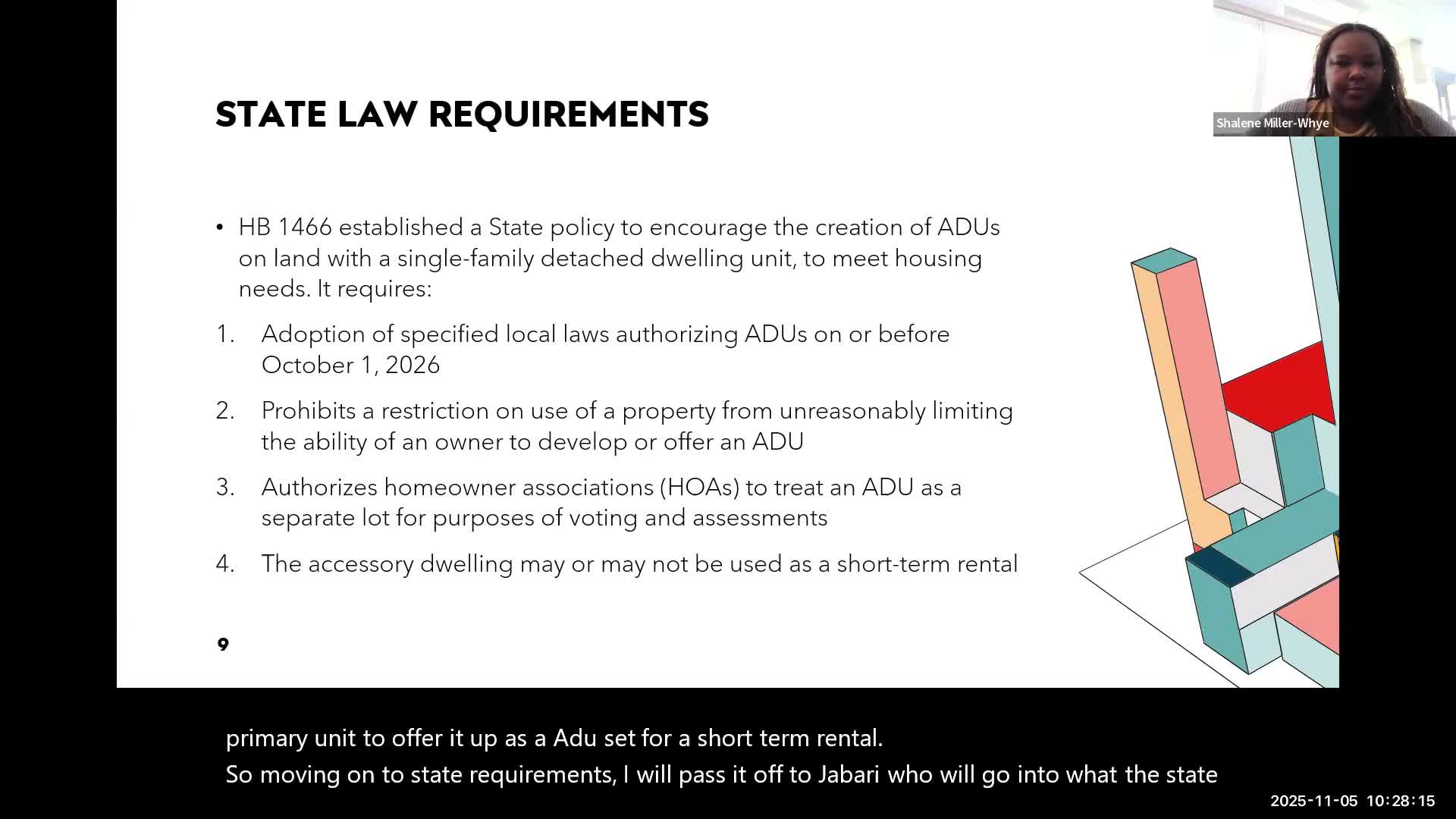State deadline drives ADU task force focus; members debate HOA limits, enforcement and parking
November 05, 2025 | Prince George's County, Maryland
This article was created by AI summarizing key points discussed. AI makes mistakes, so for full details and context, please refer to the video of the full meeting. Please report any errors so we can fix them. Report an error »

County legislative staff told the task force that state law requires county governments to authorize accessory dwelling units by Oct. 1, 2026, and allows counties to adopt objective safety and building standards but not subjective approval criteria.
“County governments, we must authorize the use of accessory dwelling units by 10/01/2026,” said Jabari Cooper, a legislative officer supporting the committee. Cooper summarized additional state provisions referenced in the presentation, including language that covenants and homeowners’ associations may not unreasonably prevent ADU development.
Staff described how other Maryland jurisdictions have approached the matter. Shailene Miller Y summarized Montgomery County’s Zoning Text Amendment 19‑01, which permits ADUs in many residential zones with size limits, and Anne Arundel County’s Bill 6‑23, which permits one ADU per lot in most residential zones and limits detached ADUs to the lesser of 800 square feet or 50% of the main house size.
Members raised distinct regulatory questions the task force will need to resolve. Cheryl Abrams Davis, representing Maryland Realtors, noted ADUs can increase options for residents to stay in place and generate rental income, while also pointing out that uptake in other jurisdictions has often been limited. Several speakers cautioned that ADU rules must be drafted to avoid creating loopholes that transform owner-occupied ADUs into investor-owned short-term rental schemes.
Participants emphasized enforcement and safety concerns. “The biggest thing that I’ve seen … is that there probably were some violations in those spaces,” Cheryl Abrams Davis said, describing existing informal conversions in the county and urging a clear pathway to legalize compliant units. Residents asked how parking demand would be managed; staff said the county could commission targeted parking studies if needed.
A resident from Bowie said local municipal codes sometimes impose stricter size caps on accessory structures than the county code; task force members agreed to examine coordination with incorporated towns and to include municipal impacts in the zoning working group’s charge.
No regulatory decisions were taken; staff and the working groups will research statutory text, comparative models and practical enforcement options and present recommendations to the full task force for subsequent deliberation and drafting.
“County governments, we must authorize the use of accessory dwelling units by 10/01/2026,” said Jabari Cooper, a legislative officer supporting the committee. Cooper summarized additional state provisions referenced in the presentation, including language that covenants and homeowners’ associations may not unreasonably prevent ADU development.
Staff described how other Maryland jurisdictions have approached the matter. Shailene Miller Y summarized Montgomery County’s Zoning Text Amendment 19‑01, which permits ADUs in many residential zones with size limits, and Anne Arundel County’s Bill 6‑23, which permits one ADU per lot in most residential zones and limits detached ADUs to the lesser of 800 square feet or 50% of the main house size.
Members raised distinct regulatory questions the task force will need to resolve. Cheryl Abrams Davis, representing Maryland Realtors, noted ADUs can increase options for residents to stay in place and generate rental income, while also pointing out that uptake in other jurisdictions has often been limited. Several speakers cautioned that ADU rules must be drafted to avoid creating loopholes that transform owner-occupied ADUs into investor-owned short-term rental schemes.
Participants emphasized enforcement and safety concerns. “The biggest thing that I’ve seen … is that there probably were some violations in those spaces,” Cheryl Abrams Davis said, describing existing informal conversions in the county and urging a clear pathway to legalize compliant units. Residents asked how parking demand would be managed; staff said the county could commission targeted parking studies if needed.
A resident from Bowie said local municipal codes sometimes impose stricter size caps on accessory structures than the county code; task force members agreed to examine coordination with incorporated towns and to include municipal impacts in the zoning working group’s charge.
No regulatory decisions were taken; staff and the working groups will research statutory text, comparative models and practical enforcement options and present recommendations to the full task force for subsequent deliberation and drafting.
View the Full Meeting & All Its Details
This article offers just a summary. Unlock complete video, transcripts, and insights as a Founder Member.
✓
Watch full, unedited meeting videos
✓
Search every word spoken in unlimited transcripts
✓
AI summaries & real-time alerts (all government levels)
✓
Permanent access to expanding government content
30-day money-back guarantee

